Human uses of animals
Human uses of animals include both practical uses, such as the production of food and clothing, and symbolic uses, such as in art, literature, mythology, and religion. All of these are elements of culture, broadly understood. Animals used in these ways include fish, crustaceans, insects, molluscs, mammals and birds.
Economically, animals provide much of the meat eaten by the human population, whether farmed or hunted, and until the arrival of mechanised transport, terrestrial mammals provided a large part of the power used for work and transport. Animals serve as models in biological research, such as in genetics, and in drug testing.
Many species are kept as pets, the most popular being mammals, especially dogs and cats. These are often anthropomorphised.
Animals such as horses and deer are among the earliest subjects of art, being found in the Upper Paleolithic cave paintings such as at Lascaux. Major artists such as Albrecht Dürer, George Stubbs and Edwin Landseer are known for their portraits of animals. Animals further play a wide variety of roles in literature, film, mythology, and religion.
Context
Culture consists of the social behaviour and norms found in human societies and transmitted through social learning. Cultural universals in all human societies include expressive forms like art, music, dance, ritual, religion, and technologies like tool usage, cooking, shelter, and clothing. The concept of material culture covers physical expressions such as technology, architecture and art, whereas immaterial culture includes principles of social organization, mythology, philosophy, literature, and science.[1] Anthropology has traditionally studied the roles of animals in human culture in two opposed ways: as physical resources that humans used; and as symbols or concepts through totemism and animism. More recently, anthropologists have also seen animals as participants in human social interactions.[2] This article describes the roles played by animals in human culture, so defined, both practical and symbolic.[3][4][5]
Practical uses
As food
The human population exploits a large number of animal species for food, both of domesticated livestock species in animal husbandry and, mainly at sea, by hunting wild species.[6][7]
Marine fish of many species, such as herring, cod, tuna, mackerel and anchovy, are caught commercially, forming an important part of the diet, including protein and fatty acids, of much of the world's population. Commercial fish farms concentrate on a smaller number of species, including salmon and carp.[6][8][9]
Invertebrates including cephalopods like squid and octopus; crustaceans such as prawns, crabs, and lobsters; and bivalve or gastropod molluscs such as clams, oysters, cockles, and whelks are all hunted or farmed for food.[10]
Mammals form a large part of the livestock raised for meat across the world. They include (2011) around 1.4 billion cattle, 1.2 billion sheep, 1 billion domestic pigs,[7][11] and (1985) over 700 million rabbits.[12]
For clothing and textiles
Textiles from the most utilitarian to the most luxurious are made from animal fibres such as wool, camel hair, angora, cashmere, and mohair. Hunter-gatherers have used animal sinews as lashings and bindings. Leather from cattle, pigs and other species is widely used to make shoes, handbags, belts and many other items. Animals have been hunted and farmed for their fur, to make items such as coats and hats, again ranging from simply warm and practical to the most elegant and expensive.[13][14]
Dyestuffs including carmine (cochineal),[15][16] shellac,[17][18] and kermes[19][20][21][22] have been made from the bodies of insects. In classical times, Tyrian purple was extracted from sea snails such as Stramonita haemastoma (Muricidae) for the clothing of royalty, as recorded by Aristotle and Pliny the Elder.[23]
For work and transport
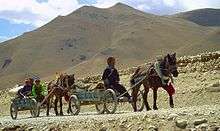
Working domestic animals including cattle, horses, yaks, camels, and elephants have been used for work and transport from the origins of agriculture, their numbers declining with the arrival of mechanised transport and agricultural machinery. In 2004 they still provided some 80% of the power for the mainly small farms in the third world, and some 20% of the world's transport, again mainly in rural areas. In mountainous regions unsuitable for wheeled vehicles, pack animals continue to transport goods.[24]
In science
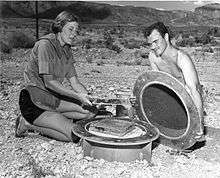
Animals such as the fruit fly Drosophila melanogaster, the zebrafish, the chicken and the house mouse, serve a major role in science as experimental models,[25] both in fundamental biological research, such as in genetics,[26] and in the development of new medicines, which must be tested exhaustively to demonstrate their safety.[27][28] Millions of mammals, especially mice and rats, are used in experiments each year.[29]
A knockout mouse is a genetically modified mouse with an inactivated gene, replaced or disrupted with an artificial piece of DNA. They enable the study of sequenced genes whose functions are unknown.[30][31]
In medicine
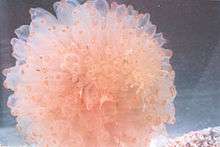
Vaccines have been made using animals since their discovery by Edward Jenner in the 18th century. He noted that inoculation with live cowpox afforded protection against the more dangerous smallpox. In the 19th century, Louis Pasteur developed an attenuated (weakened) vaccine for rabies. In the 20th century, vaccines for the viral diseases mumps and polio were developed using animal cells grown in vitro.[32]
An increasing variety of drugs are based on toxins and other molecules of animal origin. The cancer drug Yondelis was isolated from the tunicate Ecteinascidia turbinata. One of dozens of toxins made by the deadly cone snail Conus geographus is used as Prialt in pain relief.[33]
In hunting
Animals, and products made from them, are used to assist in hunting. People have used hunting dogs to help chase down animals such as deer, wolves, and foxes;[34] birds of prey from eagles to small falcons are used in falconry, hunting birds or mammals;[35] and tethered cormorants have been used to catch fish.[36]
Dendrobatid poison dart frogs, especially those in the genus Phyllobates, secrete toxins such as Pumiliotoxin 251D and Allopumiliotoxin 267A powerful enough to be used to poison the tips of blowpipe darts.[37][38]
 A poison dart frog, Phyllobates terribilis, secretes toxins powerful enough to be used to tip blowpipe darts.
A poison dart frog, Phyllobates terribilis, secretes toxins powerful enough to be used to tip blowpipe darts.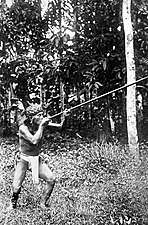 Dayak man hunting with blowpipe
Dayak man hunting with blowpipe
As pets
A wide variety of animals are kept as pets, from invertebrates such as tarantulas and octopuses, insects including praying mantises,[39] reptiles such as snakes and chameleons,[40] and birds including canaries, parakeets and parrots[41] all finding a place. However, mammals are the most popular pets in the Western world, with the most kept species being dogs, cats, and rabbits. For example, in America in 2012 there were some 78 million dogs, 86 million cats, and 3.5 million rabbits.[42][43][44] Anthropomorphism, the innate psychological tendency to attribute human-like traits to animals, is an important aspect of the way that people relate to animals such as pets.[45][46][47] There is a tension between the role of animals as companions to humans, and their existence as individuals with rights of their own; ignoring those rights has been called speciesism.[48]
For sport
A wide variety of both terrestrial and aquatic animals are hunted for sport.[49]
The aquatic animals most often hunted for sport are fish, including many species from large marine predators such as sharks and tuna, to freshwater fish such as trout and carp.[50][51]
Birds such as partridges, pheasants and ducks, and mammals such as deer and wild boar, are among the terrestrial game animals most often hunted for sport and for food.[52][53][54]
Symbolic uses
In art
Animals, often mammals but including fish and insects among other groups, have been the subjects of art from the earliest times, both historical, as in Ancient Egypt, and prehistoric, as in the cave paintings at Lascaux and other sites in the Dordogne, France and elsewhere. Famous images of animals include Albrecht Dürer's 1515 woodcut The Rhinoceros, and George Stubbs's c. 1762 horse portrait Whistlejacket.[55]

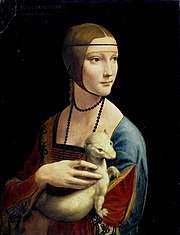 Leonardo da Vinci's The Lady with an Ermine, c. 1490
Leonardo da Vinci's The Lady with an Ermine, c. 1490_enhanced.png) Albrecht Dürer's 1515 The Rhinoceros
Albrecht Dürer's 1515 The Rhinoceros_Dragon-fly_moths_spider_beetles_with_strawberries.jpg) Jan van Kessel's A Dragon-fly, Two Moths, a Spider and Some Beetles, With Wild Strawberries, 17th century
Jan van Kessel's A Dragon-fly, Two Moths, a Spider and Some Beetles, With Wild Strawberries, 17th century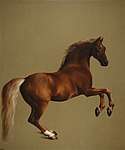 George Stubbs's c. 1762 Whistlejacket
George Stubbs's c. 1762 Whistlejacket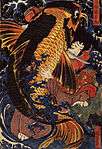 Utagawa Kuniyoshi's Saito Oniwakamaru fights a giant carp at the Bishimon waterfall, 19th century
Utagawa Kuniyoshi's Saito Oniwakamaru fights a giant carp at the Bishimon waterfall, 19th century
In literature and film
Animals as varied as bees, beetles, mice, foxes, crocodiles and elephants play a wide variety of roles in literature and film, from Aesop's Fables of the classical era to Rudyard Kipling's Just So Stories and Beatrix Potter's "little books" starting with the 1901 Tale of Peter Rabbit.[56]
A genre of films, Big bug movies,[57] has been based on oversized insects, including the pioneering 1954 Them!, featuring giant ants mutated by radiation, and the 1957 films The Deadly Mantis[58][59][60] and Beginning of the End, this last complete with giant locusts and "atrocious" special effects.[57][61]
Birds have occasionally featured in film, as in Alfred Hitchcock's 1963 The Birds, loosely based on Daphne du Maurier's story of the same name, which tells the tale of sudden attacks on people by violent flocks of birds.[62] Ken Loach's admired[63] 1969 Kes, based on Barry Hines's 1968 novel A Kestrel for a Knave, tells a story of a boy coming of age by training a kestrel.[63]
In mythology and religion
Animals including many insects[64] and mammals[65] feature in mythology and religion.
Among the insects, in both Japan and Europe, as far back as ancient Greece and Rome, a butterfly was seen as the personification of a person's soul, both while they were alive and after their death.[64][66][67] The scarab beetle was sacred in ancient Egypt,[68] while the praying mantis was considered a god in southern African Khoi and San tradition for its praying posture.[69]
Among the mammals, cattle,[70] deer,[65] horses,[71] lions,[72] bats[73][74][75][76][77] bears,[78] and wolves (including werewolves),[79] are the subjects of myths and worship. Reptiles too, such as the crocodile, have been worshipped as gods in cultures including ancient Egypt[80] and Hinduism.[81][82]
Of the twelve signs of the Western zodiac, six, namely Aries (ram), Taurus (bull), Cancer (crab), Leo (lion), Scorpio (scorpion), and Pisces (fish) are animals, while two others, Sagittarius (horse/man) and Capricorn (fish/goat) are hybrid animals; the name zodiac indeed means a circle of animals. All twelve signs of the Chinese zodiac are animals.[83][84][85]
References
- Macionis, John J.; Gerber, Linda Marie (2011). Sociology. Pearson Prentice Hall. p. 53. ISBN 978-0137001613. OCLC 652430995.
- White, Thomas; Candea, Matei; Lazar, Sian; Robbins, Joel; Sanchez, Andrew; Stasch, Rupert (2018-05-23). Stein, Felix; Candea, Matei; Diemberger, Hildegard (eds.). "Animals". Cambridge Encyclopedia of Anthropology. doi:10.29164/18animals.
- Fudge, Erica (2002). Animal. Reaktion. ISBN 978-1-86189-134-1.
- "The Purpose of Humanimalia". De Pauw University. Retrieved 12 September 2018.
animal/human interfaces have been a neglected area of research, given the ubiquity of animals in human culture and history, and the dramatic change in our material relationships since the rise of agribusiness farming and pharmacological research, genetic experimentation, and the erosion of animal habitats.
- Churchman, David (1987). The Educational Role of Zoos: A Synthesis of the Literature (1928-1987) with Annotated Bibliography. California State University. p. 8.
addressing the broad question of the relationship between animals and human culture. The committee argues that zoos should foster awareness of the involvement of animals in literature, music, history, art, medicine, religion, folklore, language, commerce, food, and adornment of the world's culture's, present and past
- "Fisheries and Aquaculture". FAO. Retrieved 8 July 2016.
- "Graphic detail Charts, maps and infographics. Counting chickens". The Economist. 27 July 2011. Retrieved 23 June 2016.
- Helfman, Gene S. (2007). Fish Conservation: A Guide to Understanding and Restoring Global Aquatic Biodiversity and Fishery Resources. Island Press. p. 11. ISBN 978-1-59726-760-1.
- "World Review of Fisheries and Aquaculture" (PDF). fao.org. FAO. Retrieved 13 August 2015.
- "Shellfish climbs up the popularity ladder". HighBeam Research. Archived from the original on 5 November 2012. Retrieved 8 July 2016.
- Cattle Today. "Breeds of Cattle at CATTLE TODAY". Cattle-today.com. Retrieved 15 October 2013.
- Lukefahr, S.D.; Cheeke, P.R. "Rabbit project development strategies in subsistence farming systems". Food and Agriculture Organization. Retrieved 23 June 2016.
- "Animals Used for Clothing". PETA. Retrieved 8 July 2016.
- "Ancient fabrics, high-tech geotextiles". Natural Fibres. Archived from the original on 15 May 2019. Retrieved 8 July 2016.
- "Cochineal and Carmine". Major colourants and dyestuffs, mainly produced in horticultural systems. FAO. Retrieved June 16, 2015.
- "Guidance for Industry: Cochineal Extract and Carmine". FDA. Retrieved 6 July 2016.
- "How Shellac Is Manufactured". The Mail (Adelaide, SA : 1912 – 1954). 18 Dec 1937. Retrieved 17 July 2015.
- Pearnchob, N.; Siepmann, J.; Bodmeier, R. (2003). "Pharmaceutical applications of shellac: moisture-protective and taste-masking coatings and extended-release matrix tablets". Drug Development and Industrial Pharmacy. 29 (8): 925–938. doi:10.1081/ddc-120024188. PMID 14570313.
- Barber, E. J. W. (1991). Prehistoric Textiles. Princeton University Press. pp. 230–231. ISBN 978-0-691-00224-8.
- Schoeser, Mary (2007). Silk. Yale University Press. pp. 118, 121, 248. ISBN 978-0-300-11741-7.
- Munro, John H. (2007). Netherton, Robin; Owen-Crocker, Gale R. (eds.). The Anti-Red Shift – To the Dark Side: Colour Changes in Flemish Luxury Woollens, 1300–1500. Medieval Clothing and Textiles. 3. Boydell Press. pp. 56–57. ISBN 978-1-84383-291-1.
- Munro, John H. (2003). Jenkins, David (ed.). Medieval Woollens: Textiles, Technology, and Organisation. The Cambridge History of Western Textiles. Cambridge University Press. pp. 214–215. ISBN 978-0-521-34107-3.
- Beaumont, Peter (5 December 2016). "Ancient shellfish used for purple dye vanishes from eastern Med". BBC. Retrieved 6 December 2016.
- Pond, Wilson G. (2004). Encyclopedia of Animal Science. CRC Press. pp. 248–250. ISBN 978-0-8247-5496-9.
- Doke, Sonali K.; Dhawale, Shashikant C. (July 2015). "Alternatives to animal testing: A review". Saudi Pharmaceutical Journal. 23 (3): 223–229. doi:10.1016/j.jsps.2013.11.002. PMC 4475840. PMID 26106269.
- "Genetics Research". Animal Health Trust. Archived from the original on 17 December 2018. Retrieved 24 June 2016.
- "Drug Development". Animal Research.info. Retrieved 24 June 2016.
- "Animal Experimentation". BBC. Retrieved 8 July 2016.
- "EU statistics show decline in animal research numbers". Speaking of Research. 2013. Retrieved January 24, 2016.
- Helen R. Pilcher (2003). "It's a knockout". Nature. doi:10.1038/news030512-17. Retrieved 24 June 2016.
- Y Zan et al., Production of knockout rats using ENU mutagenesis and a yeast-based screening assay, Nat. Biotechnol. (2003).Archived June 11, 2010, at the Wayback Machine
- "Vaccines and animal cell technology". Animal Cell Technology Industrial Platform. Retrieved 9 July 2016.
- "Medicines by Design". National Institute of Health. Retrieved 9 July 2016.
- Fergus, Charles (2002). Gun Dog Breeds, A Guide to Spaniels, Retrievers, and Pointing Dogs. The Lyons Press. ISBN 978-1-58574-618-7.
- "History of Falconry". The Falconry Centre. Retrieved 22 April 2016.
- King, Richard J. (2013). The Devil's Cormorant: A Natural History. University of New Hampshire Press. p. 9. ISBN 978-1-61168-225-0.
- "AmphibiaWeb – Dendrobatidae". AmphibiaWeb. Retrieved 2008-10-10.
- Heying, H. (2003). "Dendrobatidae". Animal Diversity Web. Retrieved 9 July 2016.
- "Other bugs". Keeping Insects. Retrieved 8 July 2016.
- Kaplan, Melissa. "So, you think you want a reptile?". Anapsid.org. Retrieved 8 July 2016.
- "Pet Birds". PDSA. Retrieved 8 July 2016.
- "Animals in Healthcare Facilities" (PDF). 2012. Archived from the original (PDF) on 2016-03-04.
- The Humane Society of the United States. "U.S. Pet Ownership Statistics". Retrieved 27 April 2012.
- USDA. "U.S. Rabbit Industry profile" (PDF). Archived from the original (PDF) on 20 October 2013. Retrieved 10 July 2013.
- Oxford English Dictionary, 1st ed. "anthropomorphism, n." Oxford University Press (Oxford), 1885.
- Hutson, Matthew (2012). The 7 Laws of Magical Thinking: How Irrational Beliefs Keep Us Happy, Healthy, and Sane. Hudson Street Press. pp. 165–181. ISBN 978-1-101-55832-4.
- Wilks, Sarah (2008). Seeking Environmental Justice. Rodopi. p. 211. ISBN 978-90-420-2378-9.
- Plous, S. (1993). "The Role of Animals in Human Society". Journal of Social Issues. 49 (1): 1–9. doi:10.1111/j.1540-4560.1993.tb00906.x.
- Hummel, Richard (1994). Hunting and Fishing for Sport: Commerce, Controversy, Popular Culture. Popular Press. ISBN 978-0-87972-646-1.
- "The World's Top 100 Game Fish". Sport Fishing Magazine. Retrieved 8 July 2016.
- "Fish species for recreational fishing". Slovenia.info. Retrieved 8 July 2016.
- "Deer Hunting in the United States: An Analysis of Hunter Demographics and Behavior Addendum to the 2001 National Survey of Fishing, Hunting, and Wildlife-Associated Recreation Report 2001-6". Fishery and Wildlife Service (USA). Retrieved 24 June 2016.
- "Recreational Hog Hunting Popularity Soaring". Gramd View Outdoors. Archived from the original on 12 December 2017. Retrieved 24 June 2016.
- Nguyen, Jenny; Wheatley, Rick (2015). Hunting For Food: Guide to Harvesting, Field Dressing and Cooking Wild Game. F+W Media. pp. 6–77. ISBN 978-1-4403-3856-4. Chapters on hunting deer, wild hog (boar), rabbit, and squirrel.
- Jones, Jonathan (27 June 2014). "The top 10 animal portraits in art". The Guardian. Retrieved 24 June 2016.
- Paterson, Jennifer (29 October 2013). "Animals in Film and Media". Oxford Bibliographies. doi:10.1093/obo/9780199791286-0044. Retrieved 24 June 2016. Cite journal requires
|journal=(help) - Tsutsui, William M. (April 2007). "Looking Straight at "Them!" Understanding the Big Bug Movies of the 1950s". Environmental History. 12 (2): 237–253. doi:10.1093/envhis/12.2.237. JSTOR 25473065.
- Gregersdotter, Katarina; Höglund, Johan; Hållén, Nicklas (2016). Animal Horror Cinema: Genre, History and Criticism. Springer. p. 147. ISBN 978-1-137-49639-3.
- Warren, Bill; Thomas, Bill (2009). Keep Watching the Skies!: American Science Fiction Movies of the Fifties, The 21st Century Edition. McFarland. p. 32. ISBN 978-1-4766-2505-8.
- Crouse, Richard (2008). Son of the 100 Best Movies You've Never Seen. ECW Press. p. 200. ISBN 978-1-55490-330-6.
- Warren, Bill (1997). Keep Watching the Skies! American Science Fiction Movies of the Fifties. McFarland & Company. pp. 325–326.
- Thompson, David (2008). 'Have You Seen ... ?' A Personal introduction to 1,000 Films. Knopf. p. 97. ISBN 978-0-375-71134-3.
- "Kes (1969)". British Film Institute. Retrieved 22 April 2016.
- Hearn, Lafcadio (1904). Kwaidan: Stories and Studies of Strange Things. Dover. ISBN 978-0-486-21901-1.
- "Deer". Trees for Life. Retrieved 23 June 2016.
- "Butterfly". Encyclopedia of Diderot and D'Alembert. Retrieved 10 July 2016.
- Hutchins, M., Arthur V. Evans, Rosser W. Garrison and Neil Schlager (Eds) (2003) Grzimek's Animal Life Encyclopedia, 2nd edition. Volume 3, Insects. Gale, 2003.
- Ben-Tor, Daphna (1989). Scarabs, A Reflection of Ancient Egypt. Jerusalem. p. 8. ISBN 978-965-278-083-6.
- "Insek-kaleidoskoop: Die 'skynheilige' hottentotsgot". Mieliestronk.com. Retrieved 9 October 2015.
- Biswas, Soutik. "Why the humble cow is India's most polarising animal". BBC. Retrieved 9 July 2016.
- Robert Hans van Gulik. Hayagrīva: The Mantrayānic Aspect of Horse-cult in China and Japan. Brill Archive. p. 9.
- Grainger, Richard (24 June 2012). "Lion Depiction across Ancient and Modern Religions". ALERT. Archived from the original on 23 September 2016. Retrieved 6 July 2016.
- Grant, Gilbert S. "Kingdom of Tonga: Safe Haven for Flying Foxes". Batcon.org. Retrieved 2013-06-24.
- "Aztec Symbols". Aztec-history.net. Retrieved 24 June 2013.
- Read, Kay Almere; Gonzalez, Jason J. (2000). Mesoamerican Mythology. Oxford University Press. pp. 132–134.
- "Artists Inspired by Oaxaca Folklore Myths and Legends". Oaxacanwoodcarving.com. Archived from the original on 10 November 2013. Retrieved 24 June 2013.
- Berrin, Katherine & Larco Museum. The Spirit of Ancient Peru:Treasures from the Museo Arqueológico Rafael Larco Herrera. New York: Thames and Hudson, 1997.
- Wunn, Ina (January 2000). "Beginning of Religion". Numen. 47 (4): 417–452. doi:10.1163/156852700511612.
- McCone, Kim R. (1987). Meid, W. (ed.). Hund, Wolf, und Krieger bei den Indogermanen. Studien zum indogermanischen Wortschatz. Innsbruck. pp. 101–154.
- Harris, Catherine C. "Egypt: The Crocodile God, Sobek". Tour Egypt.
- Rodrigues, Hillary. "Vedic Deities | Varuna". Mahavidya. Retrieved 19 January 2018.
- Bhattacharji, Sukumari (1970). The Indian Theogony: A Comparative Study of Indian Mythology from the Vedas to the Puranas. CUP Archive. p. 39. GGKEY:0GBP50CQXWN.
- Lau, Theodora, The Handbook of Chinese Horoscopes, pp. 2–8, 30–5, 60–4, 88–94, 118–24, 148–53, 178–84, 208–13, 238–44, 270–78, 306–12, 338–44, Souvenir Press, New York, 2005
- "The Zodiac". Western Washington University. Retrieved 12 December 2018.
- Tester, S. Jim (1987). A History of Western Astrology. Boydell & Brewer. pp. 31–33 and passim. ISBN 978-0-85115-446-6.

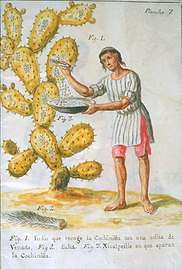
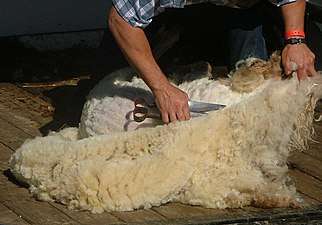
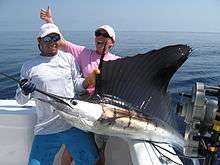
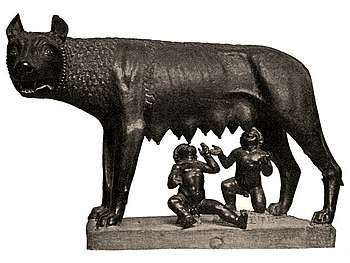
.jpg)